Corticolimbic dopamine neurotransmission is temporally dissociated from the cognitive and locomotor effects of phencyclidine
- PMID: 9651235
- PMCID: PMC6793475
- DOI: 10.1523/JNEUROSCI.18-14-05545.1998
Corticolimbic dopamine neurotransmission is temporally dissociated from the cognitive and locomotor effects of phencyclidine
Abstract
The behavioral syndrome produced by phencyclidine (PCP) and its analog ketamine represents a pharmacological model for some aspects of schizophrenia. Despite the multifaceted properties of these drugs, the main mechanism for their psychotomimetic and cognitive-impairing effects has been thought heretofore to involve the corticolimbic dopamine system. The present study examined the temporal relationship between alterations in corticolimbic dopamine and glutamate neurotransmission and two dopamine-dependent behavioral effects of PCP in the rodent that have relevance to the clinical phenomenology, namely, impairment of working memory, which is used to model the frontal lobe deficits associated with schizophrenia, and hyperlocomotion, which is used as a predictor of the propensity of a drug to elicit or exacerbate psychosis. PCP increased dopamine and glutamate efflux in the prefrontal cortex and nucleus accumbens, as measured by microdialysis. The increase in dopamine in both regions remained elevated well above baseline 2.5 hr after the injection, at which time the experiment was terminated. However, locomotor activity returned to baseline in <2 hr after injection. Furthermore, impaired performance in a discrete trial delayed alternation task, a rodent working memory task, was only evident up to 60 min after PCP injection; animals tested 80 min after injection, when cortical dopamine release was elevated at 300% of baseline, did not exhibit impaired performance. These findings indicate that activation of dopamine neurotransmission is not sufficient to sustain PCP-induced locomotion and impairment of working memory. Thus, effects of PCP, including a glutamatergic hyperstimulation, may be necessary to account for the psychotomimetic and cognitive-impairing effects of this drug.
Figures
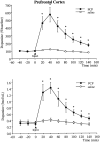
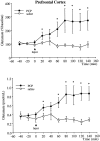


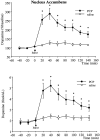

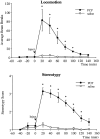
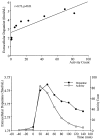

References
-
- Bakker CB, Amini FB. Observations on the psychotomimetic effects of sernyl. Compr Psychiatry. 1961;2:269–280. - PubMed
-
- Bakshi VP, Swerdlow NR, Geyer MA. Clozapine antagonizes phencyclidine-induced deficits in sensorimotor gating of the startle response. J Pharmacol Exp Ther. 1994;271:787–794. - PubMed
-
- Breier A, Su TP, Saunders R, Carson RE, Kolachana BS, de Bartolomeis A, Weinberger DR, Weisenfeld N, Malhorta AK, Eckelman WC, Pickar D. Schizophrenia is associated with elevated amphetamine-induced synaptic dopamine concentrations: evidence from a novel positron emission tomography method. Proc Natl Acad Sci USA. 1977;94:2569–2574. - PMC - PubMed
-
- Breier A, Adler C, Weisenfeld NI, Elman I, Picken L, Malhotra AK, Pickar D. Effects of NMDA antagonism on striatal dopamine release in healthy subjects: application of a novel PET approach. Synapse. 1998;29:142–147. - PubMed
Publication types
MeSH terms
Substances
Grants and funding
LinkOut - more resources
Full Text Sources
Other Literature Sources
